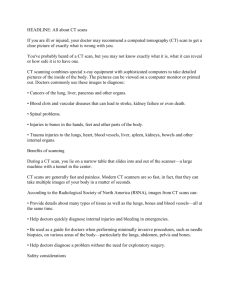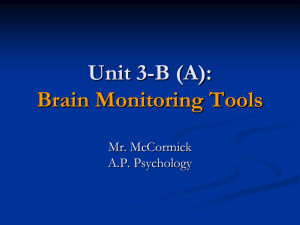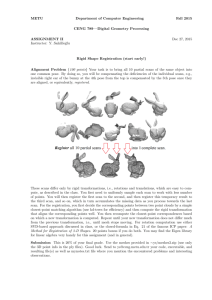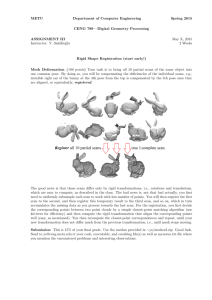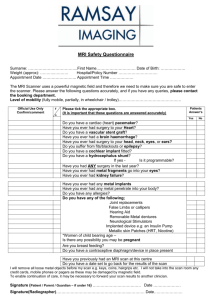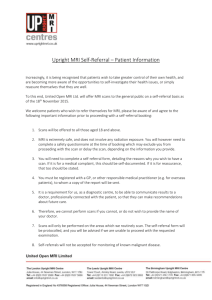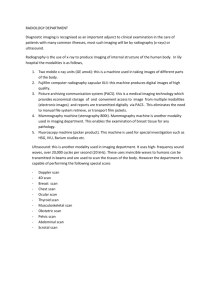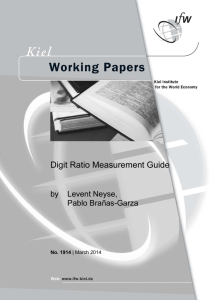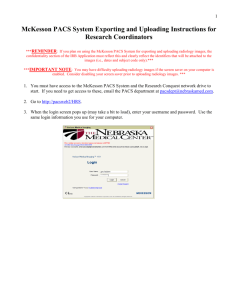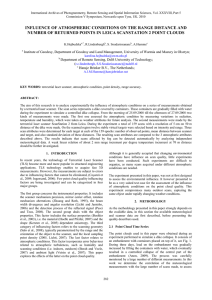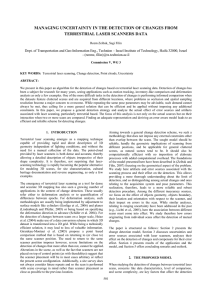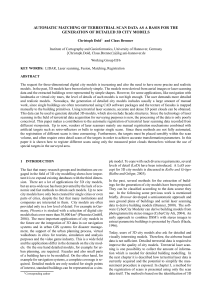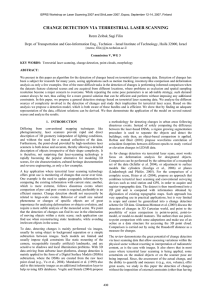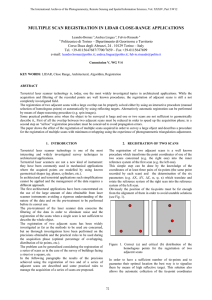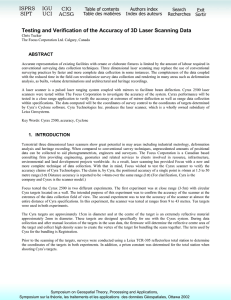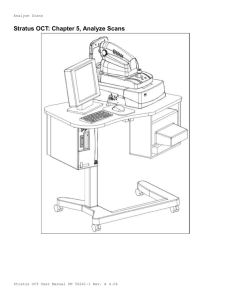CT Scans Printer Friendly Format
advertisement
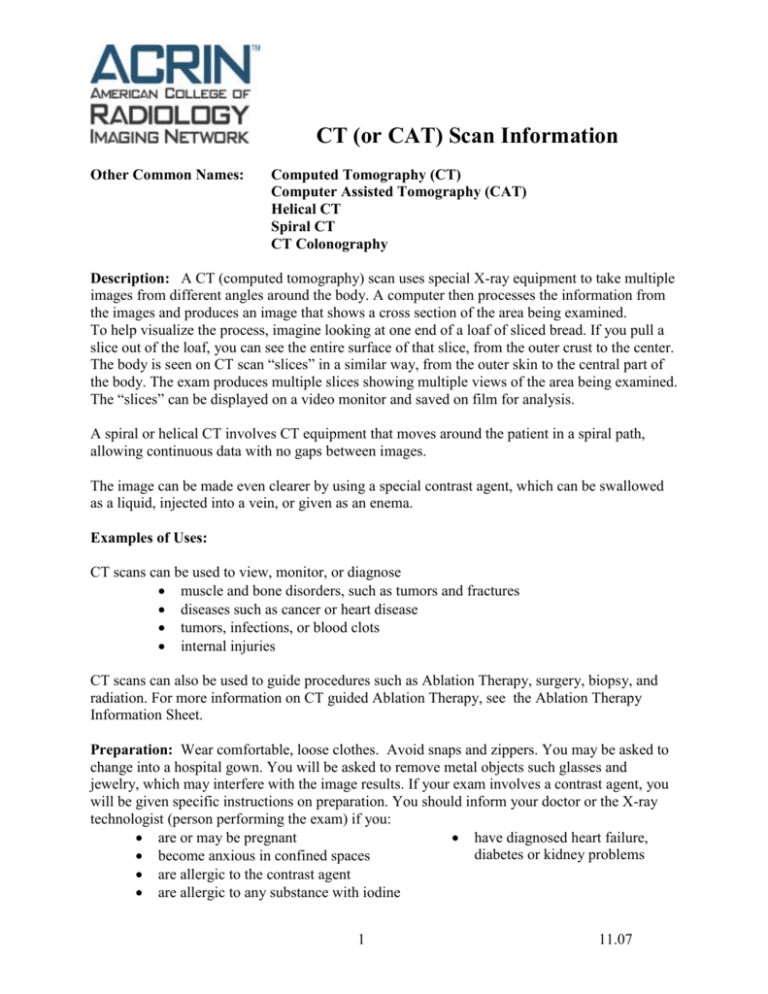
CT (or CAT) Scan Information Other Common Names: Computed Tomography (CT) Computer Assisted Tomography (CAT) Helical CT Spiral CT CT Colonography Description: A CT (computed tomography) scan uses special X-ray equipment to take multiple images from different angles around the body. A computer then processes the information from the images and produces an image that shows a cross section of the area being examined. To help visualize the process, imagine looking at one end of a loaf of sliced bread. If you pull a slice out of the loaf, you can see the entire surface of that slice, from the outer crust to the center. The body is seen on CT scan “slices” in a similar way, from the outer skin to the central part of the body. The exam produces multiple slices showing multiple views of the area being examined. The “slices” can be displayed on a video monitor and saved on film for analysis. A spiral or helical CT involves CT equipment that moves around the patient in a spiral path, allowing continuous data with no gaps between images. The image can be made even clearer by using a special contrast agent, which can be swallowed as a liquid, injected into a vein, or given as an enema. Examples of Uses: CT scans can be used to view, monitor, or diagnose muscle and bone disorders, such as tumors and fractures diseases such as cancer or heart disease tumors, infections, or blood clots internal injuries CT scans can also be used to guide procedures such as Ablation Therapy, surgery, biopsy, and radiation. For more information on CT guided Ablation Therapy, see the Ablation Therapy Information Sheet. Preparation: Wear comfortable, loose clothes. Avoid snaps and zippers. You may be asked to change into a hospital gown. You will be asked to remove metal objects such glasses and jewelry, which may interfere with the image results. If your exam involves a contrast agent, you will be given specific instructions on preparation. You should inform your doctor or the X-ray technologist (person performing the exam) if you: are or may be pregnant have diagnosed heart failure, diabetes or kidney problems become anxious in confined spaces are allergic to the contrast agent are allergic to any substance with iodine 1 11.07 During the Exam: A CT scanner looks like a large donut, with a narrow table in the middle opening. You will lie on the CT table. Pillows and straps may be used to help you hold the correct position. The table will move slowly into the opening while the X-ray tube inside the scanner rotates around your body. You will need to remain very still for up to 30 seconds during each scan set. The scan is painless. You will be alone in the room during the scan, but the technologist can see, hear, and speak to you at all times. Time Required: Under 60 minutes. Noise During Exam: Buzzing or clicking sounds. Space During Exam: You will lie on a narrow table that slides into the circular opening of the scanner. The size of the opening is usually 27 to 30 inches. How much space you feel you have around you will depend on your body size and the scanner model. If you feel any anxiety over being in enclosed spaces, let your doctor know. A mild sedative may be used to help you feel more comfortable during the exam. Benefits: CT Scans offers detailed views of many types of tissue, including bone, soft tissue, blood vessels, and lungs. CT scans are painless, non invasive, and fast. Scans can identify normal and abnormal structures, making them a useful to guide radiotherapy, needle biopsies, and other minimally invasive procedures. CT has been shown to be a cost-effective tool for a wide range of clinical problems. Risks: CT scans involve exposure to radiation in the form of X-rays. The amount of radiation exposure is variable depending upon the scan type (for example, a scan of the brain, lungs, or abdomen) and the scanner type (for example, different models and manufacturers). Because the radiation exposure is variable, the risks are also variable. Speak to your radiologist, or your physician who refers you for the CT scan, for specific details about possible radiation exposure risks. There is a rare risk of a major allergic reaction to the contrast agent. CT scans may involve additional risks if: o You are or may be pregnant and the scan is of your abdomen. Your doctor may recommend another type of test to reduce the possible risk of exposing your baby to radiation. o You have diabetes, asthma, allergies, heart disease, kidney problems, or thyroid problems. o You are breast feeding. Nursing mothers should wait 24 hours after receiving the contrast medium before resuming breast feeding. o You have already had several previous CT scans to the same part of your body. Results: A radiologist, who is a physician with specialized training in CT and other imaging tests, will analyze and interpret the results of your CT scan and then send a report to your personal physician. It usually takes a day or so to interpret, report, and deliver the results. Contact your personal physician for information on the results of your CT. 2 CT (or CAT) Scan Information For further info: http://www.radiologyinfo.org A CT Scanner A CT Image of the Lung This information, as well as additional imaging descriptions can be found on the ACRIN Patients and Families page: http://www.acrin.org/xrays_scan.html The development of lay imaging descriptions is a project of the American College of Radiology Imaging Network Patient Advocacy Committee. 3 11.07

